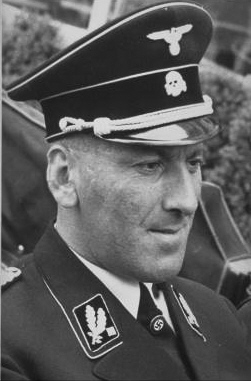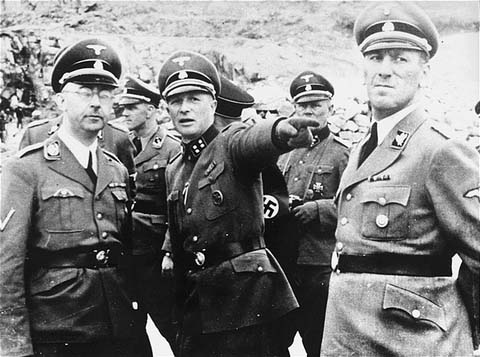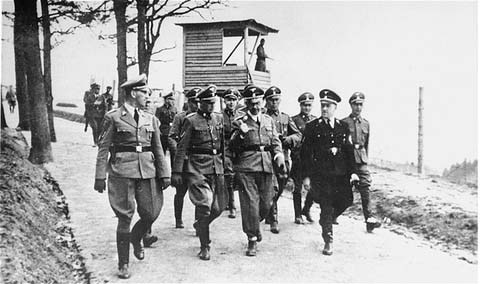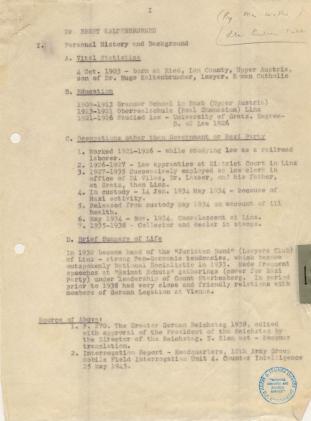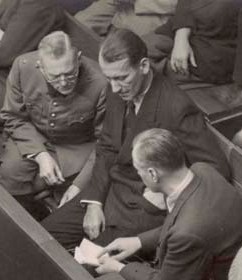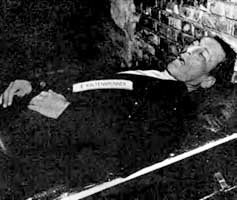Holocaust Education & Archive Research Team |
|
Holocaust Prelude Early Nazi Leaders Nazi Propaganda Nazi Racial Laws Sinti & Roma Kristallnacht The SS SS Leadership Wannsee
Prelude Articles Image Galleries | ||
Ernst Kaltenbrunner
Ernst Kaltenbrunner was born on 4 October 1903 in the valley of the Inn, near Braunau, the birthplace of Adolf Hitler. Descended from a family of country artisans – his father and grandfather, were however lawyers, Kaltenbrunner was educated in Linz, where Adolf Eichmann was one of his boyhood friends, and subsequently studied law at Graz University.
He took his doctorate in law in 1926, setting up his practice as a lawyer in Linz. Active in one of the first groups of Austrian National Socialist students and for a time a militant in the Independent Movement for a Free Austria, Kaltenbrunner eventually joined the Nazi Party in 1932.
A year later he became a member of one of the more or less camouflaged SS organisations in Austria and a spokesman for the Party in Upper Austria, providing legal advice to members and sympathizers.
In 1934 Kaltenbrunner was arrested by the Dolfuss government, and again in May 1935 he spent six months in prison on a conspiracy charge, being struck from the bar for his political activities. Shortly before his second arrest he had been appointed Commander of the Austrian SS.
After his release he worked assiduously with Seyss- Inquart for the Anschluss with Germany and as a reward for his services, was appointed by Seyss- Inquart on 2 March 1938 as Minister for State Security in Austria and promoted to SS- Gruppenfuher.
At the same time he became a member of the Reichstag, and during the next three years Kaltenbrunner was successively appointed as Commander –in – Chief of the SS and Police for the regions of Vienna, the Upper and Lower Danube and then in April 1941 Lieutenant – General of the Police.
He created an impressive intelligence network radiating from Austria south-eastwards, which caught the attention of Himmler, who to general surprise recommended him in January 1943 as head of the RSHA in Berlin in succession to Reinhard Heydrich.
In this key position as head of the Security Police (SIPO) and the Security Service (SD) Kaltenbrunner not only controlled the Gestapo but also the concentration camp system and the administrative apparatus for carrying out the “Final Solution of the Jewish Question.”
A giant of a man, nearly seven feet tall, with massive broad shoulders, huge arms, a thick square chin and deep scars from his student duelling days, Kaltenbrunner excelled in brutal repression and providing human fodder for the concentration camps.
Excitable, deceitful, self-indulgent – he was an alcoholic and a chain-smoker – he took a personal interest in various methods of execution used in the camps under his aegis and especially in the gas chambers.
Under his ruthless prodding, the RSHA organised the hunting down and extermination of several million Jews. During the war he was also responsible for the murder of Allied parachutists and prisoners of war. Kaltenbrunner had a passion for military intelligence and counter –espionage and in February 1944 he succeeded in swallowing up the foreign, and counter-intelligence departments of the Abwehr under Admiral Canaris which was reduced to a branch of his RSHA office.
Towards the end of 1944 Kaltenbrunner tried to step into Himmler’s place as the recognised mediator with the International Red Cross and to re-establish contact with the Allies through Allen Dulles, head of the United States Office of Strategic Services in Europe.
These efforts came to nothing and at the end of the war, Kaltenbrunner fled to the Tyrol, removing his headquarters to Alt-Aussee. He was picked up by an American patrol and brought before the International Military Tribunal at Nuremburg, charged with war crimes and crimes against humanity.
He was hanged in Nuremburg prison on 16 October 1946.
Sources:
Who’s Who in Nazi Germany by Robert S Wistrich, published by Weidenfeld and Nicolson, London 1982. Yad Vashem US National Archives
Copyright CW & Carmelo Lisciotto H.E.A.R.T 2007
|
